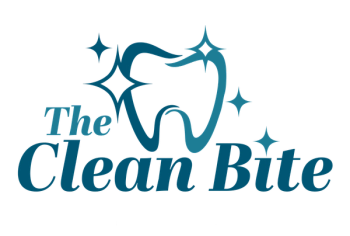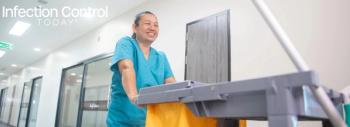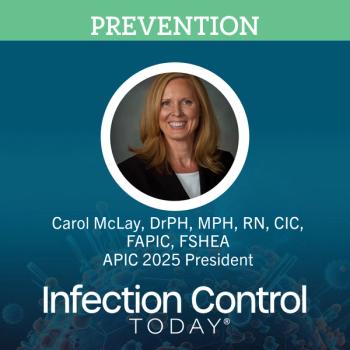
- Infection Control Today, January/February 2025 (Vol. 29 No.1)
- Volume 29
- Issue 1
Ensuring Safe Practices: Managing Surgical Instruments in the Context of Creutzfeldt-Jakob Disease
Creutzfeldt-Jakob Disease (CJD) presents significant challenges for infection control. Learn best practices for safe instrument disposal, reprocessing, and compliance with CDC and WHO guidelines.
Creutzfeldt-Jakob disease (CJD) is a widely recognized disease among medical device industry professionals that poses unique challenges for instrument reprocessing. Although care must be taken with all medical instruments, exceptional care must be taken with instruments potentially infected with CJD to ensure they are correctly disposed of or are safe for reuse. Generally, the safest and most accepted method for dealing with instruments contaminated with CJD is incineration.1,2
However, incineration is only sometimes practical. Therefore, decontamination guidelines have been provided by the CDC and the World Health Organization (WHO) and are also addressed by the Association for the Advancement of Medical Instrumentation (AAMI). Many factors must be considered when choosing instruments in preparation for a surgical procedure on a patient with CJD. In the same way, departments that handle surgical instruments must consider unknown cases of CJD and how to handle instruments that could be potentially infected with CJD.
Creutzfeldt-Jakob Disease
Before examining the disposal and decontamination guidelines for instruments confirmed to be infected or potentially infected with CJD, it is essential to understand the biological structure and impact of the disease. CJD is a type of prion disease, or a transmissible spongiform encephalopathy (TSE), that can cause abnormal folding of proteins in the body.3 This abnormal folding can lead to symptoms that progress rapidly and can often include dementia,3 unsteadiness and clumsiness,2 visual deterioration,2 and other neurological symptoms. CJD is a progressive and fatal brain disorder that has no treatment to stop the progression of symptoms or to eliminate the disease.3
According to the WHO, human TSEs (including CJD) have been caused by “exposure to infectious material through the use of human cadaveric-derived pituitary hormones, dural and cornea homografts, and contaminated neurosurgical instruments.”2 Certain infections have been tied to distinctive types of CJD.
There are 3 primary forms of CJD: sporadic, genetic (familial), and acquired (can include iatrogenic).4 Sporadic CJD is the most common form, accounting for 85% of reported cases.5 Sporadic cases of CJD occur when proteins already present in the body fold abnormally for an unknown reason.5 Genetic (or familial) CJD occurs when genetic mutations are inherited from a family member with CJD.6 Iatrogenic cases are acquired in health care settings through contact with prions that can come from contaminated medical instrumentation.5 Due to this, guidelines for disposing and reprocessing medical instruments that have been potentially contaminated have been shared by the CDC and WHO and are included in ANSI/AAMI ST79:2017: Comprehensive Guide to Steam Sterilization and Sterility Assurance in Health Care Facilities.7,8
Notably, a variant form of CJD (considered acquired4), also known as vCJD, is classified as a bovine spongiform encephalopathy (BSE),9 a type of TSE that affects cows. Although similar in name to CJD, human infections of vCJD have primarily been attributed to the consumption of animal products from BSE-infected cows.9,10 Because of this, most available research on instrument decontamination has been reviewed for classic CJD. However, WHO guidelines specify that instruments used for patients with confirmed or suspected cases of vCJD shall be decontaminated following the guidance listed in the WHO Infection Control Guidelines for Transmissible Spongiform Encephalopathies,2 which also includes guidance for classic CJD.
Prion Resistance to Decontamination and Sterilization
Instruments confirmed to be infected with CJD and instruments potentially infected with CJD must be treated differently from standard instrumentation as this type of disease resists common decontamination and sterilization practices.2
Incineration or Reprocessing of Instrumentation
Due to CJD’s resistance to standard reprocessing protocols, the CDC and WHO recommend incinerating instruments exposed to high-infectivity tissues.1,2 High-infectivity tissues are those of the central nervous system, including the brain, spinal cord, and eyes.2 The CDC and WHO have also discussed methods for instruments that are not incinerated.
It should be noted that all methods detailed below should be followed by cleaning the instruments, rinsing them in water, and subjecting them to routine sterilization.1,2 According to the WHO Infection Control Guidelines for Transmissible Spongiform Encephalopathies, heat-resistant instruments may be immersed in sodium hydroxide (NaOH) and run through a gravity displacement autoclave at 121 °C for 30 minutes.1,2 The WHO lists recommendations for heat-resistant instruments, starting with the most severe treatments. Aside from incineration, the NaOH/gravity displacement autoclave method is considered the most severe treatment.2
Another method cited by the WHO and CDC suggests immersing instruments in 1N NaOH or sodium hypochlorite for an hour, transferring them to water, and heating them in a gravity displacement autoclave at 121 °C for an hour.1,2 The last method cited by the CDC that aligns with WHO recommendations is to immerse the instruments in NaOH or sodium hypochlorite for an hour, remove and rinse in water, transfer to an open pan, and either heat in a gravity displacement autoclave at 121 °C or a porous load autoclave at 134°C for an hour.1,2 The least severe treatment in the WHO recommendations for heat-resistant instruments is autoclaving at 134 °C for 18 minutes.2
Of course, not all instruments used in a surgical procedure are heat resistant. For instruments that are heat sensitive, the CDC suggests, “heat-sensitive reusable instruments…should be decontaminated. This can be done by flooding with or soaking in 2N NaOH or undiluted sodium hypochlorite for 1 hour. They should [then] be rinsed with water,” which aligns with WHO recommendations.1,2 Care must be taken during these processes to ensure the safety of staff handling the contaminated instruments and chemical agents.
Safety and Instrument Concerns
While there are circumstances in which the previous methods may be appropriate, certain challenges related to instrument composition, practicality, and the safety of reprocessing professionals must be considered. In its guidance, the WHO states that hypochlorite can be corrosive to stainless steel instruments and should not be used to soak instruments while in an autoclave, as this could cause corrosion in the autoclave itself.2 Hypochlorite also poses a potential respiratory hazard if the process is not conducted in a properly ventilated location.2 The CDC recommends that when instrument composition and chemical intolerances are unclear, the manufacturer should be consulted.1 In this scenario, the instrument’s instructions for use (IFU) could also be a useful reference. In addition, staff should always wear proper protective equipment when they are in contact with CJD and the chemical agents used in these procedures.2
Instruments Potentially Infected
As mentioned, understanding how to handle instruments potentially infected with CJD is essential to ensure the safety of all reprocessing staff. The WHO recognizes that it is impractical for every instrument used on an individual potentially infected with CJD to be unnecessarily incinerated, so instruments may be quarantined until suspected cases have been confirmed.2
However, this raises a question for many industry professionals: What is considered a potentially infected instrument? Not all CJD cases may be suspected during a surgical procedure. Do all instruments used on high-infectivity tissues (eg, the brain, spinal cord, and eyes) have the potential to be infected with CJD if an individual was not tested before surgery?
The CDC touches on this topic in its guidance by stating, “[if] it’s not yet known if a patient undergoing neurosurgery has CJD (or another prion disease)…instruments involved in these procedures should be reprocessed as if the patient has suspected or confirmed CJD.”1
Reprocessing all high-infectivity tissue instrumentation as if infected with CJD seems to be the safest method to avoid prion contamination, but how many reprocessing facilities comply with this guidance? Is this guidance practical for all health care facilities? Aligning recommendations and elaborating on this topic between WHO, CDC, ANSI/AAMI, and even the manufacturers’ IFUs would greatly benefit reprocessing staff to comply with best practices.
Conclusion
CJD’s resistance to standard decontamination protocols presents unique challenges for reprocessing staff. While incineration is generally the preferred method for managing instruments potentially infected with CJD, this is not always practical. To address this, decontamination guidance has been shared by the CDC, WHO, and ANSI/AAMI ST79:2017 for instruments that cannot be incinerated.
Unknown cases of CJD present yet another challenge when managing instrumentation. Continued advocacy from professionals in the medical device industry is essential to clarify best practices for unknown cases of CJD and promote the alignment of current recommendations.
References
- Infection control for CJD. CDC. May 13, 2024. Accessed December 9, 2024.
https://www.cdc.gov/creutzfeldt-jakob/hcp/infection-control/index.html - WHO infection control guidelines for transmissible spongiform encephalopathies: report of a WHO consultation, Geneva, Switzerland, 23-26 March 1999. World Health Organization. Accessed December 9, 2024.
https://iris.who.int/handle/10665/66707 - Clinical overview of Creutzfeldt-Jakob disease (CJD). CDC. May 13, 2024. Accessed December 9, 2024.
https://www.cdc.gov/creutzfeldt-jakob/hcp/clinical-overview/index.html - Prion diseases are a group of rare, neurodegenerative brain disorders. CJD Foundation. Accessed December 9, 2024.
https://cjdfoundation.org/types-of-prion-disease/#acquired - Classic Creutzfeldt-Jakob disease. CDC. May 13, 2024. Accessed December 9, 2024.
https://www.cdc.gov/creutzfeldt-jakob/about/index.html - CJD diagnostic criteria. CDC. May 13, 2024. Accessed December 9, 2024.
https://www.cdc.gov/creutzfeldt-jakob/hcp/clinical-overview/diagnosis.html - Asked & answered: device disposal. Association for the Advancement of Medical Instrumentation. March 1, 2020. Accessed December 9, 2024.
https://array.aami.org/content/news/asked-answered-device-disposal - ANSI/AAMI ST79:2017 with amendments A1:2020, A2:2020, A3:2020, A4:2020: comprehensive guide to steam sterilization and sterility assurance in health care facilities. Association for the Advancement of Medical Instrumentation. Accessed December 9, 2024.
https://aami.org/standards/featured-standards/ansi-aami-st79 - Clinical overview of variant Creutzfeldt-Jakob disease. CDC. November 12, 2024. Accessed December 9, 2024.
https://www.cdc.gov/variant-creutzfeldt-jakob/hcp/clinical-overview/index.html - About prion diseases. CDC. April 22, 2024. Accessed December 9, 2024.
https://www.cdc.gov/prions/about/index.html
Articles in this issue
Newsletter
Stay prepared and protected with Infection Control Today's newsletter, delivering essential updates, best practices, and expert insights for infection preventionists.





